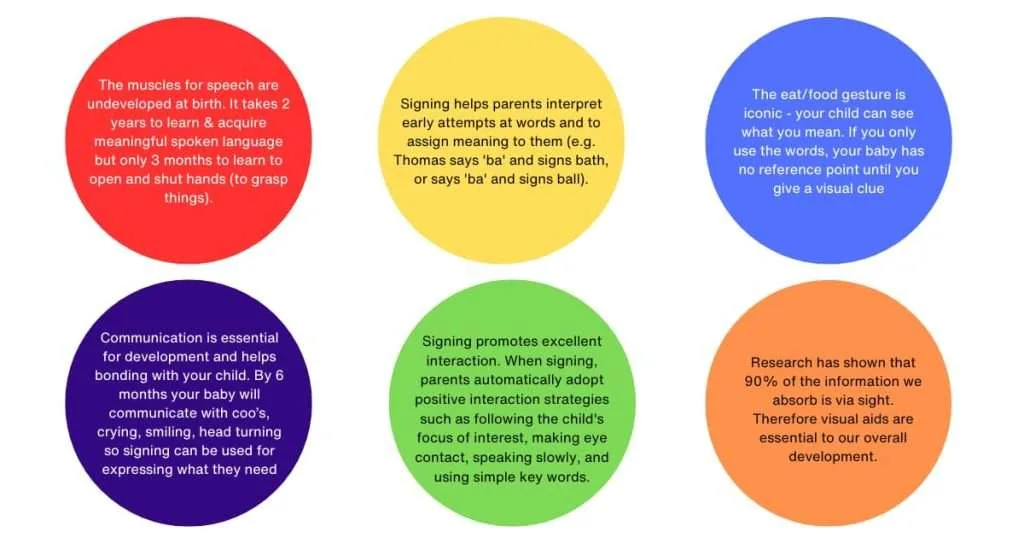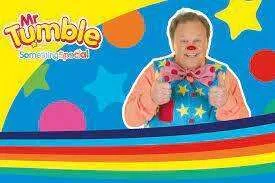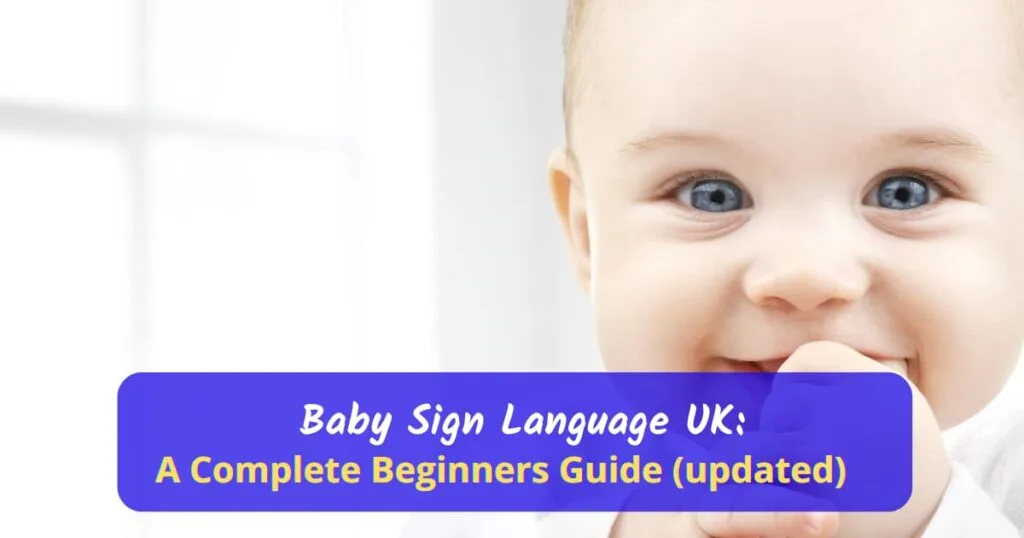How do you get your baby to sign ‘hungry’? Or ‘tired’? Baby sign language is incredibly popular in the UK. Why? Because it can transform the connection between you and your baby. It can be a valuable tool to bridge the communication gap during those crucial early years.
We all know the universal gestures such as waving at someone to say hello. Signing adds to and enhances communication for pre-verbal babies and toddlers. By using sign language with your baby, you can reduce frustration and promote a stronger bond between you and your child.
Table of Contents
- What is Baby Sign Language?
- Why Should You Use Sign Language With Your Baby?
- What Age Should You Start Teaching Baby Sign Language?
- Is Baby Sign the Same as Makaton?
- Does Using Sign Language Delay Speech?
- What are the Best Signs to Teach a Baby?
- How Do I Teach My Baby to Sign in the UK?
- Dont’s!
- Baby Signing Classes
- Baby Sign Apps and websites:
- Baby Sign Books
- Baby Sign YouTube Clips
- A World of Connection Awaits
What is Baby Sign Language?
The term baby sign language is slightly misleading. The signs you teach your baby are simplified gestures and hand motions that are used in British Sign Language. They are simplified because babies do not have the manual dexterity to do the correct signs.
Signing will help your baby develop their language and cognitive skills by using a visual language. This is really useful for babies as it allows them to express their needs and emotions before they can efficiently communicate using speech.
Why Should You Use Sign Language With Your Baby?
Adding sign language to your parenting routine has many benefits. It helps both you and your baby. Parents often use sign language to talk with infants. Letting your baby show how they feel and what they want with gestures helps you understand and help them. This can cut down on meltdowns and tantrums.
Dr Garcia developed the idea of Baby Sign Language several years ago. Key points to note from Dr Joseph Garcia’s work include:

Every parent and baby or toddler goes through the “I don’t know what you want” stage, which can be frustrating. Signing does not stop this altogether, but it helps to make communication easier.
Using sign language fosters a deeper connection between you and your child. It does so by promoting active engagement and interaction. This bonding experience can improve your child’s social and emotional development. It will give them a sense of security and trust in their relationship with you, their caregiver.
Key studies by Dr Linda Acredolo and Dr Susan Goodwyn supports using sign language with babies. Signing can improve thinking and language skills. The researchers have published their work in the U.S. in many papers and books. One of the most notable is “Baby Signs: How to Talk with Your Baby Before Your Baby Can Talk.”
Their research found that babies who used sign language had a larger vocabulary. They also scored higher on IQ tests at 8 years old. They had better language skills than those who did not use sign language. Other researchers have also studied the benefits of using sign language with babies. They have seen similar positive effects on thinking and language.
Babies who learn to sign often have better language skills. This early exposure to gestures can lay the groundwork for learning. It can aid the development of language and thinking skills.
Using sign language with your baby improves your communication and bonding with your child. It also builds their intellectual, social, and emotional growth.
What Age Should You Start Teaching Baby Sign Language?
Most information online says the ideal age to introduce sign language to your baby is 6 to 8 months old. But deaf families who use BSL as their first language introduce signs to babies at 6 – 8 weeks old. Babies at this age recognise faces and can track movements. So, introducing a sign such as ‘milk’ will help with early communication development. If you start early, you can introduce more signs over the following months.
The sign ‘Milk’. Clip by Kelly Medina:
From 3 to 6 months, babies are more attentive. They can better focus on your hand movements. They can start to learn the motor skills needed to mimic gestures. They also start to learn what sounds mean. Signing can strengthen that with visual cues.
When you start teaching your baby sign language, be patient. Adjust your approach to their pace. Language develops in stages. Every baby is unique, so their readiness to learn sign language may vary.
Consistency is key. Try adding signs to your daily routines. You can do this during mealtime, playtime, or nappy changes. As your baby grows, their thinking skills advance. You can add harder signs and grow their signing vocabulary.
It’s never too late to start teaching sign language, even if your child has already begun speaking. Older infants and toddlers can still benefit from learning signs. Signs can aid their language and boost their confidence in expressing themselves.
Above all, you must adapt your approach to your child’s needs and development. This is essential to ensure a positive and effective learning experience.
Is Baby Sign the Same as Makaton?
Baby sign language and Makaton are similar, but they are not the same. Both aim to help communication with gestures and signs, but BSL is a recognised language; Makaton is not.
Baby sign language is for preverbal infants and their caregivers. It uses simplified gestures and hand movements. The signs come from traditional sign languages such as British Sign Language (BSL) and American Sign Language (ASL). Baby sign language’s main purpose is to let you and your baby ‘talk’ before your baby can speak.
Makaton is a UK communication system that uses signs, symbols, and speech. It helps people with learning difficulties or communication disorders. Makaton uses a set vocabulary of signs and symbols, and it uses signs alongside speech. This system is widely used in special education. It is also used with people who have speech and language issues. Like baby sign, it uses signs from traditional sign language.

Mr Tumble on CBeebies uses Makaton, not sign language. The signs are similar to baby sign language
While both baby sign language and Makaton use gestures and signs to help communication, they serve different groups. Baby sign language is for on pre-verbal infants and their parents. Makaton is for people with learning difficulties or communication disorders. Makaton uses a structured approach with a specific set of signs and symbols.
Does Using Sign Language Delay Speech?
Many parents worry about this, especially if they have a baby with hearing loss. Does using sign language slow speech development? Research and evidence suggest that this is not the case. In fact, sign language can support and improve speech development in young children.
For deaf children, researchers advise that teaching language should start early. This is to avoid ‘language deprivation‘. Accessing language is a crucial part of cognitive and emotional development.
Studies have shown that babies who were taught sign language exhibited had better language skills. They had better language skills and bigger vocabularies. This was compared to their non-signing peers. Teaching and learning signs with words helps babies. It gives them a better understanding of language and communication.
The reason is that sign language does not replace speech. Instead, it complements and reinforces it. So, we encourage you to use signs alongside spoken words. This allows your baby to associate gestures with their meanings. Your baby will develop their motor skills to make hand signs. They will also be working on their speech. Eventually, spoken words will replace the need for signs.
Using sign language with your baby does not delay speech development. On the contrary, it can support and enhance their language skills. baby sign will provide an additional means of communication and understanding during their pre-verbal stage.
What are the Best Signs to Teach a Baby?
When you start to teach your baby sign language, focus on practical signs. Use signs that relate to your baby’s daily needs and experiences. Here are some of the most useful signs to begin with:
- Milk: This sign is used to indicate breastfeeding or bottle-feeding and is especially helpful for babies to communicate their hunger.
- More: This versatile sign can be used in various contexts, such as asking for more food, playtime, or cuddles.
- Eat: Teach your baby the sign for ‘eat‘ to help them express when they’re hungry or ready for a meal.
- Sleep: The sign for ‘sleep’ can help your baby communicate when they’re tired and ready for a nap or bedtime.
- All done: This sign is useful for babies to indicate when they’ve finished eating or playing, or when they want to be changed or taken out of their high chair.
- Bath: This sign is useful for your baby to indicate when they want to take a bath or are ready to get out of the tub.
- Play: The sign for ‘play’ helps your baby express their desire for playtime or to engage with a specific toy.
Other essentials signs include signs for pain or discomfort, family, friends, pets, health and safety signs (e.g. no touch – hot!). You could add other signs such as ‘where’ to use at playtimes (e.g. for playing hide and seek with a toy). Check out our list below to find links to video clips showing the signs.
By focusing on these essential signs, you’ll give your baby the tools they need to communicate their basic needs. This will make day-to-day interactions smoother and more enjoyable for both of you.
How Do I Teach My Baby to Sign in the UK?
You can use baby signs anywhere there is an opportunity to communicate. It is essential that teaching your baby sign language is a fun and rewarding experience for both you and your child. To ensure success, consider the following tips and strategies:
Top tips to start baby signing
- Speak slowly and clearly but in a natural way
- Keep it simple, using just one sign per sentence
- Be consistent in the signs you use but happily accept any signing attempts from the young child
- Be patient and relaxed about baby signing, using lots of praise
- Follow your baby’s lead and from nine months onwards, observe what interests your child and introduce signs that will mirror this
Strategies for baby signing
- Start early: You can introduce signing when your baby is around 3 – 6 months old. This is when they begin to develop the motor skills and attentiveness needed to learn and imitate gestures.
- Eye contact: when your baby is able to use steady eye contact, you can use this as an opportunity to sign
- Consistency and repetition: Be consistent in using signs and repeat them frequently. This helps your baby associate the gesture with its meaning and reinforces their learning.
- Use spoken language: Always pair signs with spoken words. This helps your baby understand the connection between the sign and the word, supporting their speech development.
- Incorporate signs into daily routines: Integrate signing into your everyday activities, such as mealtime, playtime, bath time, and bedtime. This contextual use of signs helps your baby better understand their meaning and application.
- Keep it simple: Start with a few basic signs that are most relevant to your baby’s needs and experiences. Gradually introduce new signs as they become more confident and proficient.
- Make it interactive and fun: Use songs, stories, and games to make signing an enjoyable and engaging experience for your baby. This will encourage their interest and motivation to learn.
- Visual aids: Use picture books, flashcards, or videos that feature signs to provide additional visual reinforcement and help your baby remember the gestures.
- Be patient and positive: Every child learns at their own pace, so be patient and provide plenty of encouragement and praise as they progress.
- Involve family members: Encourage other caregivers, siblings, and family members to learn and use the signs as well. This consistent use of sign language across different settings will reinforce your baby’s learning.
Remember to keep signs simple. Use them at the relevant time. For example, use the food sign for all mealtimes or use the ‘milk’ sign for both water and milk. If you offer both at the same time, your child can choose which one they want.
Dont’s!
- Baby sign is not BSL: if you meet a deaf person who uses BSL, avoid explaining that you know a few “signs”. It could come across as disrespectful and patronising.
- Don’t get frustrated or show frustration. If you don’t enjoy it, stop doing it! If you feel baby sign isn’t working then don’t carry on regardless. Be guided by your baby and your own feelings when using baby sign, if it doesn’t feel right, then stop using it. There are plenty of other ways to bond with your baby.
- Don’t use your child as a circus animal. As your child grows, they may not appreciate being asked to show their signing to others. Baby sign language is used to help you communicate with your baby at the pre-verbal stage of their life.
By following these tips and incorporating sign language into your parenting routine, you’ll be well on your way to helping your baby develop effective communication skills and fostering a strong bond between the two of you.
Baby Signing Classes
Baby signing classes are a great way to learn signs but also to connect with other parents and make friends. Classes can can support your journey in teaching your baby. here is our recommended list:
- You can also check Signature for course providers that run family signing courses like Famlingo.
Baby Sign Apps and websites:
- Cbeebies have a range of resources for learning baby sign.
- Where is the bird? is a book and app that teaches signs through a story
- Twinkl is a website with a vast number of resources (paper-based and videos) to help you teach baby signs.
Baby Sign Books
Books by Cath Smith are a fantastic resource for learning sign language, including the BSL Baby Sign book. This book has engaging visual images and includes the added benefit of videos that show you each sign.
Other books include Baa Baa Black Sheep which is a sign and singalong book.
Baby Sign YouTube Clips
Commanding hands is a YouTube channel that teaches a wide range of signs. Baby signs include milk, food and bed.
Twinkl have YouTube shorts channel that teaches baby signs including animal signs and mealtime signs.
Caution: Not all baby signing videos are equal
There are inaccurate ‘baby sign’ videos on YouTube. Some signs will be too advanced for babies so you may find your baby reject some signs that might too complex to do. That is why we recommend the resources listed above as a starting point. We will share more resources, such as links to video clips, as we find them.
A World of Connection Awaits
Teaching your baby sign language, presents a unique opportunity for you and your child to connect. You can communicate on a deeper level, even before speech develops. By teaching your baby sign language, you can reduce frustration and strengthen your bond. You’ll also support their cognitive, linguistic, and emotional growth. The benefits of signing extend far beyond its immediate practical uses. It lays a strong foundation for your child’s future development.
You may find that you enjoy using sign language so much that you want to learn the essential greetings and much more. Check out our guides and study tips for learning BSL.
Related articles:

